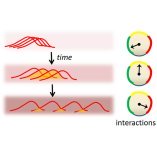September 03, 2014
Most recently, Nest Fellow Prof. Darrick Chang, leader of the research group on Theoretical Quantum Nano-photonics, in collaboration with Dr. Vladan Vuletic, from the Massachusetts Institute of Technology, and Dr. Mikhail D. Lukin, from Harvard University, have published an outstanding review article in Nature Photonics entitled “ Quantum nonlinear optics – photon by photon” .
Scientists have known for over half a century that light fields can interact inside nonlinear optical media, but the nonlinearity of conventional materials can only be observed at the high powers associated with lasers. A long-standing goal in optical science has been to realize nonlinear effects at progressively lower light powers and pulse energies. The ultimate limit would be that of “quantum nonlinear optics,” in which the individual photons interact so strongly with one another that even one versus two photons propagate in very different ways.
In this review, the team of researchers has described the remarkable advances occurring in the world of quantum optics, which have recently culminated in the demonstration of several methods for generating optical nonlinearities at the level of individual photons. These systems include single atoms coupled to high-finesse optical cavities, ensembles of atoms coupled to micro- and nano-photonic systems, and atomic Rydberg gases in which strong atom-atom interactions produce strong photon-photon interactions.
In addition, they have provided an overview of promising applications of this field. In particular, systems exhibiting strong photon–photon interactions could be used to construct unique devices such as single-photon switches and all-optical transistors, all-optical quantum information processors, and non-destructive photon number counters, as well as enable the generation and investigation of exotic quantum correlated states of light and matter.
Link to the Paper
Link to the research group led by Darrick Chang

Progress in Quantum Nonlinear Optics
Controllable photon-photon interactions to enable unique applications

Exhibition of strong quantum optical nonlinearities - overlapping photons that order themselves to form “crystal” of light











